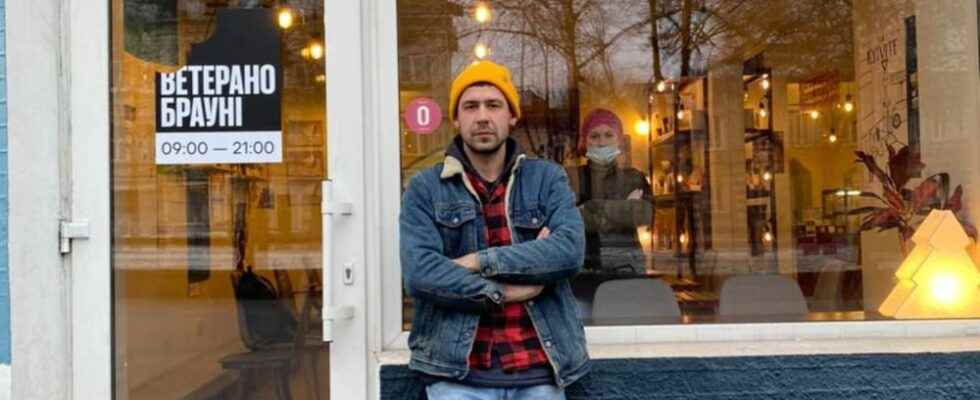On Facebook, veteran Roman Nabozhniak chats with his former brothers in arms. “In the east, nothing new”, estimates for the moment this veteran of the war in Donbass about the situation on the border without knowing if the Russians are really preparing to invade his country. While waiting for diplomacy, embodied by the activism of Emmanuel Macron, to produce results or not, this fellow of 31 years mobilized from 2014 to 2016 against pro-Russian insurgents, chats with his friends in a tone that oscillates between serious and the joke. The topic of the moment? Find, in Kiev, a building high enough to unfurl a banner saying “Welcome to hell”, as the Chechens had done in Grozny to welcome Russian soldiers during the two wars in this region of the North Caucasus .
A veteran of the war in Donbass, Roman Nabozhniak, 31, was mobilized from 2014 to 2016 against pro-Russian separatist insurgents.
Roman Nabozhniak
Russian tanks penetrating Ukraine, targeted airstrikes, cybernetic or political destabilization operations: Roman considers and prepares for all scenarios. At home, his kit – a backpack full of clothes and a first aid kit – is ready. The 30-year-old knows that, like most of the 400,000 Ukrainian veterans, he is potentially mobilized in the event of a new military offensive. “Here is my land and I will not leave it because a madman in Moscow, ie Putin, considers Ukraine a pseudo-state.”
Even if the Ukrainian authorities want to be reassuring, a growing part of the population is worried and anticipates the next movements of Moscow, which has continued since the end of 2021 to position troops and military equipment at the border. According to a survey of the Razoumkov Center, a sociological institute, nearly 45% of Ukrainians say they would gladly take part in armed or civilian resistance in the event of a Russian offensive.
President Volodymyr Zelensky, he announced in early February a plan to professionalize the army. Before Parliament, he signed a decree planning to increase the army’s workforce by 100,000 people over three years, in addition to the nearly 250,000 current soldiers, with the creation of 20 new brigades. The end of military service is also planned, by 2024.
In a catastrophic state eight years ago, the Ukrainian army has been modernized with the help of the West since 2014. The army today benefits from the crucial contribution of weapons, in particular the TB2 combat drones of the manufacturer Turkish Bayraktar, who played a key role in the 2020 conflict between Azerbaijan and Armenia. Not to mention the British and American anti-tank missiles. On the human level, the Ukrainian forces also have hundreds of thousands of reservists and have integrated volunteer battalions into the army.
Roman Nabozhniak volunteered to go to the front in 2015 while still a student. After the revolution in Maidan Square in Kiev in 2014, the sieges of the cities of Ilovaisk (in the summer of 2014) and Debaltseve (beginning of 2015), which had cost the lives of several hundred Ukrainian soldiers, made his home click office. “We had been fighting in the east for months and I thought that we had to replace these soldiers who had been there from the start,” recalls Roman.
“It was clear that the war was here to stay,” continues this computer scientist who wanted to make himself useful. He then left his job and his family to get involved. In order to compensate for his lack of military experience, he trains for months. First, he watches NATO training videos on YouTube. Then he trains with friends in a Kiev park, a replica Kalashnikov in his hand. Then, he joined the army for good at the age of 25, before joining the front for fourteen months. Already at the time, the conflict stabilized with the signing of the Minsk 2 agreements. It therefore participates in the war of trenches and waiting which has continued since then – and which has caused 13,000 deaths on the Ukrainian side.
A veteran of the war in Donbass, Roman Nabozhniak, 31, was mobilized from 2014 to 2016 against pro-Russian separatist insurgents.
Roman Nabozhniak
In 2016, Roman was demobilized, with no apparent injuries but with some psychological problems. The former computer scientist rests, travels abroad, and is passionate about cooking in order to channel his post-traumatic stress. With help from the Kyiv School of Economics, which set up an incubator to reintegrate veterans into civilian life, Roman opened his own cafe, Veterano Brownie, in 2019 in a trendy area of Kyiv. “This business was my therapy,” explains this brownie maker, who now employs fifteen people.
The lack of support from the State, particularly psychological, the difficulty of returning to work is often offset by initiatives from civil society. “It’s a bit of a way for her to thank veterans for their service to the country,” said Serhiy Gvozdiov, one of the program’s teachers. In this time of tension and concern, he says he is reassured by the preparation and resilience of the former soldiers at the Veterano Brownies café. “With people like Roman and his family, he reassures himself, we know that we can rest easy.”
